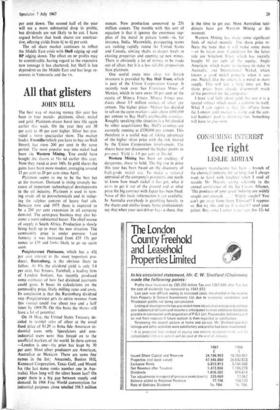All that glisters
JOHN BULL
The best way of making money this year has been in four metals: platinum, silver, nickel and gold. Platinum.shares burst into life again earlier this week. On the year they are 30 per cent to 40 per cent higher. Silver has pro- vided a more spectacular show. The market leader, Fresnillo (which you have to buy on Wall Street), has risen 200 per cent in the same period. The most popular way into nickel had been via Western Mining. You could have bought the shares at 51s 6d earlier this year. Now they stand at over I 60s. In gold shares the gains have been more modest, averaging around 15 per cent to 20 per cent since April.
Platinum seems to me to be the best bet at the moment. Demand is rising strongly be- cause of important technological developments in the oil industry. Platinum is used in turn- ing crude oil to petrochemicals and in reduc- ing the sulphur content of heavy fuel oils. Between now and 1975 there is expected to be a 200 per cent expansion in oil company demand. The aerospace business may also be- come a more substantial buyer. The chief source of supply is South Africa. Production is slowly being built up to meet the new situation. The commodity price is under pressure. Last January it was increased from £35 15s per ounce to £39 and looks likely to go up again soon.
Potgietersrust Platinums, which has a 43+ per cent interest in the most important pro- ducer, Rustenburg, is the obvious share to follow. At 80s the dividend yield is only 3.4 per cent, but Strauss, Turnbull, a leading firm of London brokers, has recently produced some estimates of how fast dividend payments could grow. It bases its calculations on the commodity price, likely milling rates and costs. Its conclusion is that the Rustenburg dividend rate (Potgietersrust gets its entire revenue from this source) could rise about two and a half times by 1969-70. On this basis the shares still have a lot of potential.
On 18 May, the United States Treasury de- cided to restrict sales of silver at the usual fixed price of $1.29 to bona fide American in- dustrial users only. Speculators and non- industrial users were thus forced on to the unofficial markets of the world. In these centres —London is one—the price has leapt by 30 per cent. Most silver producers are American,. Australian or Mexican. There are some fine names in the list: Anaconda, Bunker Hill, Kennecot Corporation, Texas Gulf, and Mount Isa (the last name ranks number one in Aus- tralia). How long will the silver boom last? On paper there is a big gap between supply and demand. In 1966 Free World consumption for industrial purposes alone totalled 356.5 million
ounces. New production amounted to 231 million ounces. The trouble with this sort of equation is that it ignores the enormous sup- plies of the metal in private hands—in, for instance, India. Meanwhile, prospecting teams are rushing rapidly round the United States and Canada, sinking shafts to deeper levels in existing properties and opening up new mines. There is obviously a lot of money to be made out of silver, but it is a less reliable proposition than platinum.
One useful route into silver for British investors is provided by Bay Hall Trust, which is part of the Union Corporation Group. It recently took over San Francisco Mines of Mexico, which in turn owns 30 per cent of the equity of Minera Frisco. Minera Frisco pro- duces about 3.5 million ounces of silver per annum. The higher price—Mexico has decided to sell on the open market—adds about £100,000 per annum to Bay Hall's attributable earnings. Roughly speaking (the situation is a bit clouded by other acquisitions) Bay Hall's earnings are currently running at £339,000 per annum. This therefore is a useful way of taking advantage of the higher silver price with the risk limited by the Union Corporation involvement. The shares have not discounted the higher profits in prospect. Yield is 4.9 per cent at 26s 6d.
Western Mining has been an exciting, if dangerous, share to hold. The big rise in price this year has been based on the discovery of high-grade nickel ore. To make a rational appraisal of the company's prospects, one needs to know how much nickel it has got, what it costs to get it out of the ground and at what .price the big contract with Japan has been fixed. None of this basic information is yet available. In Australia everybody is gambling heavily in the shares and similar issues. Some professionals say that when your taxi-driver buys a share, that is the time to get out. Most Australian taxi- drivers have got Western Mining at the moment.
Western Mining has made some significant finds of nickel. recently. The share price re- flects the hope that it will make some more —or be taken over. Candidates for the latter role are Selection Trust. which has recently bought 10 per cent of the equity:. Anglo American. which wants to increase its stake in Australia; and International Nickel, which knows a good nickel property when it sees one. Nickel, like the others. is a metal in short supply. This will last a little time yet. But share prices have already discounted much of the potential for the companies.
I have suid little about gold, he,•,i use it is a special subject which needs a column to itself. What I can report is that the otrtake from the London gold market is rising and the cen- tral bankers' pool is shrinking fast. Something will have to give soon.






































 Previous page
Previous page